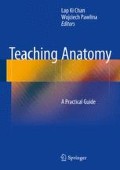Abstract
Anatomy provides a rich environment to learn from cadaveric resources. Cadaveric resources are a rich environment for learning anatomy. Anatomy laboratory sessions can use cadaveric resources in either dissection- or prosection-based modes of teaching. Each mode presents advantages in how it allows students to examine and explore the three-dimensional structural organization of the human body. When designing anatomy laboratory sessions, the advantages of each of these modes need to be considered. Once a mode of teaching has been determined, learning activities should be designed that are engaging, contextual and clinically relevant. Anatomy laboratory activities can creatively embed graduate attributes like teamwork, critical thinking, and communication skills. Multidimensional learning activities that relate cadaveric anatomy to living anatomy will ensure student engagement and enthusiasm. Designing and implementing anatomy laboratory activities should be based on a model of continuous improvement that involves review and refinement based on student feedback and evaluation.
Access this chapter
Tax calculation will be finalised at checkout
Purchases are for personal use only
References
Yeager VL. Learning gross anatomy: dissection and prosection. Clin Anat. 1996;9:57–9.
Patel KM, Moxham BJ. Attitudes of professional anatomists to curricular change. Clin Anat. 2006;19(2):132–41.
Rizzolo LJ, Stewart WB, O’Brien M, Halms A, Rando W, Abrahams J, Dunne S, Wang S, Aden M. Design principles for developing an efficient clinical anatomy course. Med Teach. 2006;28(2):142–51.
Berube D, Murray C, Schultze K. Cadaver and computer use in the teaching of gross anatomy in physical therapy education. J Phys Therapy Educ. 1999;13(2):41–6.
Nnodim JO. Learning human anatomy: by dissection or from prosections? Med Educ. 1990;24(4):389–95.
Nnodim JO, Ohanaka EC, Osuji CU. A follow-up comparative study of two modes of learning human anatomy: by dissection and from prosections. Clin Anat. 1996;9(4):258–62.
Drake RL, McBride JM, Lachman N, Pawlina W. Medical education in the anatomical sciences: the winds of change continue to blow. Anat Sci Educ. 2009;2(6):253–9.
Turney BW. Anatomy in the modern curriculum. Ann R Coll Surg Engl. 2007;89(2):104–7.
Johnson J. Importance of dissection in learning anatomy: personal dissection versus peer teaching. Clin Anat. 2002;15:38–44.
Gogalniceanu P, Hardi M, Paraskevas AP, Darzi A. Anatomy teaching in the 21st century—dead cool or cold dead? Anat Sci Educ. 2008;1(3):136–7.
Granger NA. Dissection laboratory is vital to medical gross anatomy education. Anat Record 2004;281B:6–8.
McLachlan JC, Bligh J, Bradley P, Searle J. Teaching anatomy without cadavers. Med Educ. 2004;38(4):418–24.
Parker LM. Anatomical dissection: Why are we cutting it out? Dissection in undergraduate teaching. Aust NZ J Surg. 2002;72(12):910–2.
Pabst R, Rothkotter HJ. Retrospective evaluation of undergraduate medical education by doctors at the end of their residency time in hospitals: consequences for anatomical curriculum. Anat Rec. 1997;249:431–4.
Lempp HK. Perceptions of dissection by students in one medical school: beyond learning about anatomy. A qualitative study. Med Educ. 2005; 39(3):318–25
McLachlan JC. New path for teaching anatomy: living anatomy and medical imaging vs dissection. Anat Record 2004;281B:2–14.
O’Carroll RE, Whiten S, Jakson D, Sinclair DW. Assessing the emotional impact of cadaver dissection on medical students. Med Educ. 2002;36:550–4.
Cahill KC, Ettarh RR. Attitudes to anatomy dissection in an Irish medical school. Clin Anat. 2009;22(3):386–91.
Dinsmore CE, Daugherty S, Zeitz HJ. Teaching and learning gross anatomy: dissection, prosection, or both of the above? Clin Anat. 1999;12:111–4.
Michaelsen LK, Watson WE, Cragin JP, Fink LD. Team-based learning: A potential solution to the problems of large classes. Exchange Org Behav Teach J. 1982;7(4):18–33.
Michaelsen LK, Knight AB, Fink LD. Team-based learning: a transformative use of small groups. New York: Praeger; 2002.
Skidmore JR. The case for prosection: comment on R.L.M. Newell’s paper. Clin Anat. 1995;8:128–30.
Lattore RM, García-Sanz MP, Moreno M, Hernández F, Gil F, López O, Ayala MD, Ramírez G, Vázquez JM, Arencibia A, Henry RW. How useful is plastination in learning anatomy? Vet Med Educ. 2007;34(2):172–6.
Fruhstorfer BH, Palmer J, Brydges S, Abrahams PH. The use of plastinated prosections for teaching anatomy-the view of medical students on the value of this learning resource. Clin Anat. 2011;24(2):246–52.
McKeown PP, Heylings DJA, Stevenson M, McKelvey KJ, Nixon JR, McCluskey DR. The impact of curricular change on medical students’ knowledge of anatomy. Med Educ. 2003;37(11):954–61.
Camp CL, Gregory JK, Lachman N, Chen LP, Juskewitch JE, Pawlina W. Comparative efficacy of group and individual feedback in gross anatomy for promoting medical student professionalism. Anat Sci Educ. 2010;3(2):64–72.
Sweller J. Cognitive load theory, learning difficulty and instructional design. Learn Instr. 1994;4:295–312.
Khalil MK, Paas F, Johnson TE, Payer AF. Interactive and dynamic visualizations in teaching and learning anatomy: a cognitive load perspective. Anat Rec. 2005;386B:8–14.
Granger NA, Calleson D. The impact of alternating dissection on student performance in a medical anatomy course: are dissection videos an effective substitute for actual dissection? Clin Anat. 2007;20(3):315–21.
Ganguly PK, Chan LK. Living anatomy in the 21st century: how far can we go? South East Asian J Med Educ. 2008;2(2):52–7.
Fakoya FA. Integrating ultrasound technology into teaching gross anatomy: point of order! Med Educ Online. 2013;18:20888.
Swamy M, Searle RF. Anatomy teaching with portable ultrasound to medical students. BMC Med Educ. 2012;12:99.
Böckers A, Mayer C, Böckers TM. Does learning in clinical context in anatomical sciences improve examination results, learning motivation, or learning orientation? Anat Sci Educ. 2014; 7(1):3–11.
Vasan NS, DeFouw DO, Holland BK. Modified use of team-based learning for effective delivery of medical gross anatomy and embryology. Anat Sci Educ. 2008;1:3–9.
Author information
Authors and Affiliations
Corresponding author
Editor information
Editors and Affiliations
Rights and permissions
Copyright information
© 2015 Springer International Publishing Switzerland
About this chapter
Cite this chapter
Pather, N. (2015). Teaching Anatomy: Prosections and Dissections. In: Chan, L., Pawlina, W. (eds) Teaching Anatomy. Springer, Cham. https://doi.org/10.1007/978-3-319-08930-0_24
Download citation
DOI: https://doi.org/10.1007/978-3-319-08930-0_24
Published:
Publisher Name: Springer, Cham
Print ISBN: 978-3-319-08929-4
Online ISBN: 978-3-319-08930-0
eBook Packages: MedicineMedicine (R0)

